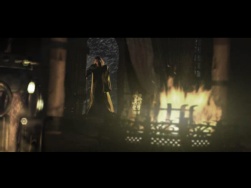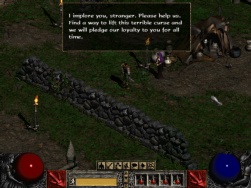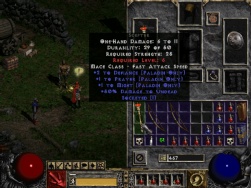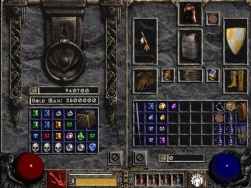|
Diablo II
 |
| Impressive cinematics for its time |
If you told me I'd be playing Diablo II again thirteen years after it came out (and seven years since my
first run through it), I'd have told you you were nuts. If you told me that I would bother to write a review after playing
it, well, I'd have told you you were bat guano insane. And yet, that's what I seem to be doing here. After nearly four
solid weeks of playing it. As a single character class. But there you go. I suppose the reason is that it's so well designed
to draw you in and keep you looking for that next-magical-item-that-will-change-the-whole-game that it becomes addictive.
However, even though I'd played it all the way through before with a single Barbarian character, it wasn't such smooth sailing
this time, because I did a lot of experimenting. Let's just say there were some... casualties along the way. I had to abandon
two characters that were going nowhere at around the level 20 mark (Stegnar and Ankur, if I recall correctly) until I managed
to strike the right balance on my third attempt, and created a laid-back Necromancer (ahem! Sir Drednab to you) that I felt
I could complete the game with. More on that score later.
Diablo II is, of course, the sequel to Diablo (1996), which I never played. That was probably because I
usually read a lot of reviews before I buy a game, and Diablo II was deemed by all of them to be yonks ahead of
its predecessor. What enticed me to drag it off the shelf and fire it up again? A little big of digging around reveals that
it was rated in the top 10 games of all time by both PC Gamer (all genres, no. 6) and IGN (top 100 RPGs, no. 7). And they
weren't wrong to put it there. Diablo II is a hack n' slash type action RPG, where the main goal is ostensibly to
defeat the demon Diablo and his minions. But actually, it's a devilishly crafted way for packrats and stats fanatics to get
their jollies. And as alluded to above, finding a magical item with just the right properties at an early enough stage in the
game can be a game changer. Like the Necromancer wand I recovered after an unremarkable battle on my last run through: + 2 to
Raise Skeleton, + 2 to Skeleton Mastery, and +1 to Corpse Explosion :-)
 |
| The lady seems sincere... not buying it though |
The game plays out in four rather long acts, with some very nice cinematics leading into each act. At the start of
the game, you get to choose from one of five different character classes:
- Amazon - her main talents lie with bows, spears, and other thrown weapons.
- Barbarian - can wield dual weapons, and has the ability to stun opponents with his fearsome war cries.
- Necromancer - can summon dead creatures and elementals to fight by his side, and makes use of curses to weaken his
opponents.
- Paladin - uses auras and heavenly spells to increase the power of his weapons.
- Sorceress - the most mage-like character class in Diablo II, almost exclusively using spells in combat.
Diablo II is simpler than most full-blown RPGs when it comes to character traits, in that there are only four:
Strength, Dexterity, Vitality, and Energy. Strength is self-evident, and determines primarily what armour you can wear,
what melee weapons you can wield, and how much extra damage these do. Dexterity limits your ability to effectively use
bows and thrown weapons. Vitality governs how many health points you have, and also determines how long you can run
away from trouble like a deranged lunatic until you have to stop to recharge. Energy controls how much Mana you have
available to cast spells and throw curses. What's notably missing is a Charisma attribute, because you don't need to
influence any dialogue decisions in Diablo II as all the conversations are in one direction: NPCs imparting
information or giving you simple quests. Speaking of which, don't expect to get any of these that aren't of the
go-there-and-fetch-this/kill-that variety. Still, it works.
Each character class has their own skill tree. Generally, you have to build up from basic skills (that you may not even
want) to get to the more powerful skills. These only become available at certain character levels: 6, 12, 18, 24, and 30
depending on how powerful the skill is. There is an exception to this rule, in that finding a magical item that grants a
skill to your character class can put you right in the middle of the skill tree (if you are at a sufficient level), even
if you didn't have any of the prerequisite skills in that branch of the skill tree. As with most other RPGs, you attain
early levels faster with only a small gain in experience points. It takes longer to attain the next level the further you
get into the game, the point scale being logarithmic. But this is pretty standard fare for RPGs.
 |
| Now that's what I call a scepter! Socketed, too :-) |
If you are unfortunate enough to be saddled with carpal tunnel syndrome, I'd give this one a miss. Unless you
are playing a Necromancer, you'll be doing mostly all the fighting yourself, and this involves a lot of left-mouse
button clicking to run and attack, interspersed with a bit less right-mouse button clicking to cast spells and such.
Diablo II allows you to map function keys F1 - F8 to skills accessible by the right-mouse button, so you can keep
swapping in the appropriate skill you want to use next, while the left-mouse button is usually reserved for running and
attacking. For example, a typical in-combat sequence for my Necromancer would involve hitting F2 (that's just the way I
had it mapped) followed by the right-mouse button to raise a skeleton, and then hitting F5 (again, my choice) to enable
the right-mouse button to cast the Amplify Damage curse on a group of enemies. And the enemies come at you fast and furious
in this game. Sometimes it can be in waves seemingly with nary a pause in between, and it can become quite tiring. And that
brings us to the next point.
This is probably the least attractive feature of Diablo II, especially for mature gamers like myself who can't
always afford to dedicate hours on end to it. Whenever you die in battle, or save and exit the game, you are placed back
in the town that is your home base at the start of each act. Dying in battle can be a real bitch, as you lose everything you
have equipped at the time. If you want to continue from there, you have to re-equip your character back in town, and then
fight your way back to where your 'corpse' is lying on the ground to reclaim all your valuable gear. Invariably the stuff
you temporarily equipped yourself with to do this is just throw-away then. There is a trick you can use though. If you save
and exit the game after dying, your corpse is right there in town when you start up the game again, so at least you don't
have to re-equip and fight your way back to reclaim your gear. But... then you have to fight your way back through all the
new enemies, which re-spawn each time you start up the game. There are teleporters scattered sparsely around the areas in
each act, and once you find one in your travels and activate it, you can then zap right over there from town. This does help
things a bit, as these act as pseudo save points. Also, there are useful items called Scroll of Town Portal that you can
purchase. When you activate one of these, a portal that gets you back to town pops up right there. Handy when you have a lot
of loot to pick up and can't fit it all in your inventory.
 |
| The battles are suitably epic in the latter stages of the game |
In each of the act's base towns there are a variety of characters that you can buy health and mana potions,
weapons, and armour from. There is also an NPC that you can hire one mercenary at a time from to fight alongside you. This
option is not available in the very last act where you must face Diablo, though. But it wouldn't make any difference as
Diablo would wipe out a weaker character like that in about one second.
Getting back to those marvellous magical items that I was mentioning earlier, there are two types: weapons and armour that
have magical properties attached to them (like: adds 1 to maximum damage), and also gems (er... and skulls). Gems and skulls
can be placed into 'socketed' items which then inherit the properties of the gem or skull. For instance, emeralds confer
poison damage over time to weapons, and grant a certain percentage of poison resistance to shields. But the most valuable gem
in the long run turns out to be the lowly topaz, which when inserted into a socketed helm gets you a 9% better chance of finding
magical items. And this leads to the essential winning strategy in Diablo II: every weapon, piece of armour, ring, and
amulet that you have equipped has to have as many magical properties as possible that will grant you an advantage in battle,
especially when you are facing the formidable boss at the end of each act. There is an item that you find almost midway through
the game that allows you to combine rough gems into more refined varieties that are even more powerful. Each type of gem or
skull has 4 grades: chipped, flawed, unflawed, and perfect. Each higher grade of gem is of course more powerful. Unfortunately,
once you have placed a gem in a socketed item, it can't be removed. So it's a constant process of selling your older socketed
items, and building ever more powerful ones as the game progresses.
You can only fit so much in your inventory, but you are given a stash (that is a 6 x 4 grid) where you can safely store items
in town for future use. Your stash moves with you from act to act, and this is where you also store your coins. You need to
be careful with these gold coins, because any that you are carrying on your person when you die are lost forever.
 |
| Anybody wanna buy a gem? Some lovely skulls going real cheap, too |
Not long after Diablo II's release came the Lord of Destruction expansion set. This included a fifth act,
two new character classes (Druid and Assassin), and a new socketing concept known as Runewords, where the order runes (a bit
like gems) were socketed in items could create items with powers almost beyond belief. As you can imagine, messing with which
runes in which order did what led to lots of experimentation and wiki writing. You also got the ability to equip and heal your
mercenaries, which was sorely missed in Diablo II where you can't interact with them at all, and they just fight until
they die and you go hire a new one. Though very tempting at a mere $9.99 and still available to this day, I have so far resisted
getting the expansion set. Life is too short. Likewise, although Diablo II has a thriving on-line playing community up on
battle.net, 13-year olds with attitude is not my cup of tea, so I never bothered with on-line play.
Wrapping up, I'd like to leave you with a war story concerning my adventures with various incarnations of a Necromancer. At
first I thought it was a great idea to build a fighting Necromancer, and have less powerful skeletons and golems to support you
in battle. But this turns out to only get you so far because you are splitting skill points at each level between summoning
skills and your own combat skills. I found that instead, it's better to pour all your skill points into Raise Skeleton and
Skeleton Mastery. Pretty soon, you will be able to raise 6 skeletons at one time, and each one will be doling out 40 - 50
points of damage per strike. You just sit back with a wand that enhances your skeletons or golems, and watch the show,
occasionally casting Amplify Damage to double the damage they are doing. The only bad side effect of this strategy is that aside
from using topazes in your helm to increase your ability to find magic items, you have little use for all the gems and skulls
you find, thus the last woeful screenshot showing a stash full of wasted gems :-(
Well, it should be patently obvious from reading this review that Diablo II is one of the best games ever made, and
probably the best action RPG out there. So what are you waiting for? But a word of caution is in order: this game will consume
you.
Copyright © Steve Metzler 2013.
All rights reserved.
System Requirements:
Anything from Windows 98 upwards, though from XP onwards you will need to patch the game to the latest version, which
was 1.13 at the time of writing. This patch may be downloaded from many locations on the web.
|
